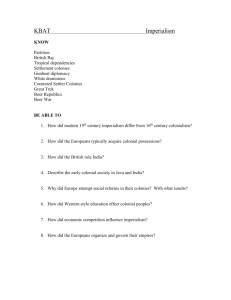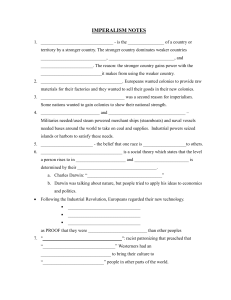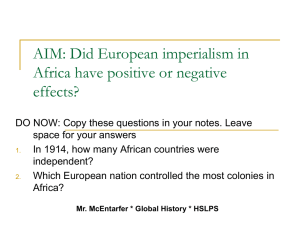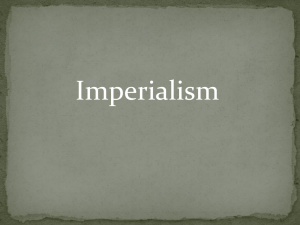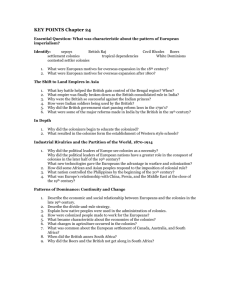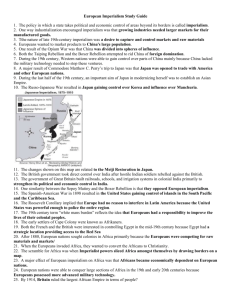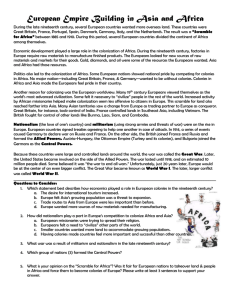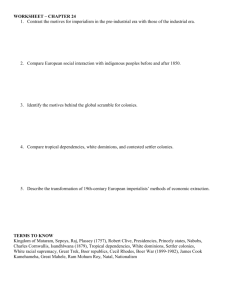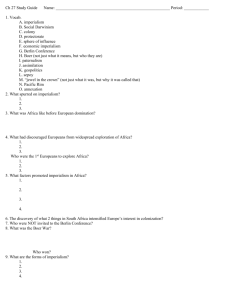AP World History
advertisement
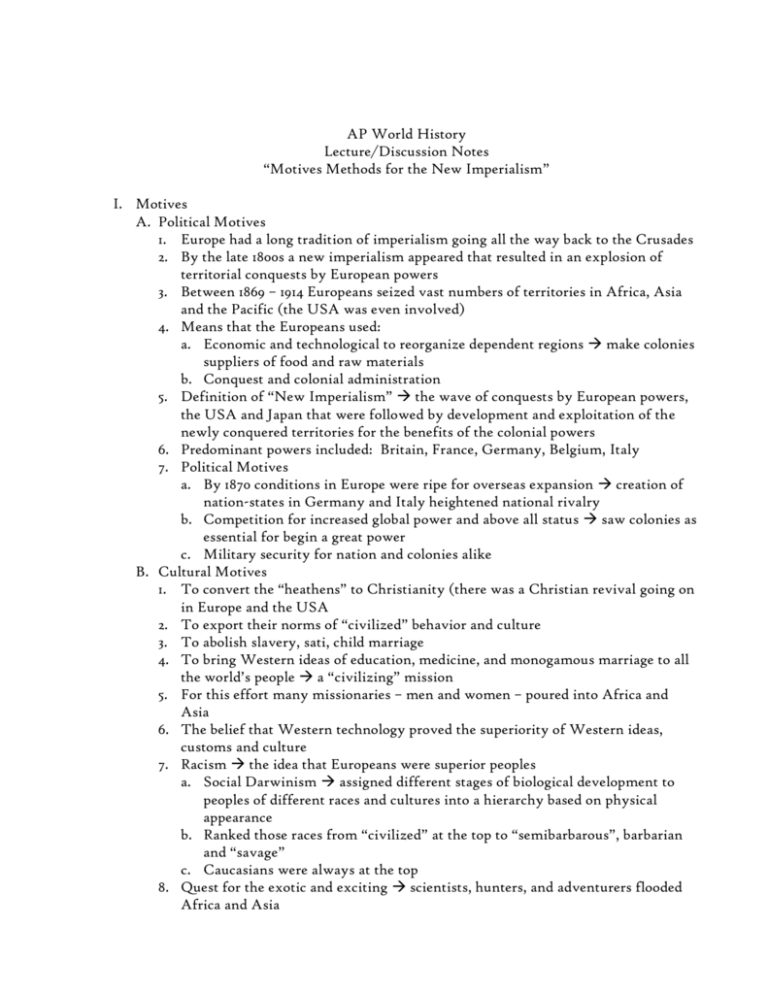
AP World History Lecture/Discussion Notes “Motives Methods for the New Imperialism” I. Motives A. Political Motives 1. Europe had a long tradition of imperialism going all the way back to the Crusades 2. By the late 1800s a new imperialism appeared that resulted in an explosion of territorial conquests by European powers 3. Between 1869 – 1914 Europeans seized vast numbers of territories in Africa, Asia and the Pacific (the USA was even involved) 4. Means that the Europeans used: a. Economic and technological to reorganize dependent regions make colonies suppliers of food and raw materials b. Conquest and colonial administration 5. Definition of “New Imperialism” the wave of conquests by European powers, the USA and Japan that were followed by development and exploitation of the newly conquered territories for the benefits of the colonial powers 6. Predominant powers included: Britain, France, Germany, Belgium, Italy 7. Political Motives a. By 1870 conditions in Europe were ripe for overseas expansion creation of nation-states in Germany and Italy heightened national rivalry b. Competition for increased global power and above all status saw colonies as essential for begin a great power c. Military security for nation and colonies alike B. Cultural Motives 1. To convert the “heathens” to Christianity (there was a Christian revival going on in Europe and the USA 2. To export their norms of “civilized” behavior and culture 3. To abolish slavery, sati, child marriage 4. To bring Western ideas of education, medicine, and monogamous marriage to all the world’s people a “civilizing” mission 5. For this effort many missionaries – men and women – poured into Africa and Asia 6. The belief that Western technology proved the superiority of Western ideas, customs and culture 7. Racism the idea that Europeans were superior peoples a. Social Darwinism assigned different stages of biological development to peoples of different races and cultures into a hierarchy based on physical appearance b. Ranked those races from “civilized” at the top to “semibarbarous”, barbarian and “savage” c. Caucasians were always at the top 8. Quest for the exotic and exciting scientists, hunters, and adventurers flooded Africa and Asia L/D “Motives Methods for the New Imperialism” 2 C. Economic Motives 1. The Second Industrial Revolution stimulated the demand for minerals of all kinds, diamonds, and gold, oil, cotton, rubber, as well as sugar, coffee, tea, and tobacco these resources were predominantly in Africa and Asia 2. An insurance against shortage of raw materials and loss of overseas markets 3. Growing economic rivalry between old industrial states like Britain and France and new ones like Germany and the USA added to the competition 4. The depression of 1875 – 1895 caused European merchants and industrialists to seek protections from foreign competition a. Need secure sources of raw materials and protected markets b. Little experience in handling overproduction and unemployment and diminished exports c. Concerned about the possibility of social and economic unrest 5. Investors saw an opportunity to get richer from profits from mines, plantations and railroads in Africa and Asia 6. The economies of Africa and Asia were eventually reorganized to serve the needs of the European economies a. Roads and railroads were built to move raw materials b. Mining sectors developed c. Vast areas were converted to the production of commodities 7. Profits went mainly to European merchants and industrialists raw materials sent to Europe than transformed into finished goods which were mainly intended for Europeans II. Methods of the New Imperialism A. Tools of Empire Building 1. The “New Imperialists” needed the means to achieve their objectives at reasonable costs 2. Scientific discoveries and technological innovations had catapulted the Europeans far ahead of all other peoples particularly in war 3. Europeans dominance of the seas a. Naval power increased with the introduction of steamships b. Development of more efficient engines helped to defray costs c. Building of the Suez Canal greatly cut shipping costs d. Global network of submarine telegraph cables increased communication capabilities 4. Military Dominance a. Use of smaller gunboats on the major river basins b. Deadlier firearms and light artillery breechloader that could fire accurately ten times as fast and five times farther than a musket i. Repeating rifles ii. Machine guns c. Other deadly explosives d. Railroads gave the Europeans fast mobility and ability to supply large armies e. What did the natives have spears, arrows, leather shields and perhaps primitive muskets L/D “Motives Methods for the New Imperialism” 3 5. Discovery of quinine to prevent malaria among the colonizers 6. Public opinion newspapers promoted the idea of colonies as patriotic B. Colonial Administration 1. Colonialism the system of administering and exploiting colonies for the benefit of the home country 2. Types of colonies a. Protectorates retained their traditional governments but had a European “resident” or “consul-general” to advise them b. Tropical dependencies with direct administration a European governor who ruled over large populations of native peoples c. Settlement colonies i. White dominions descendents of European settlers made most of the population because the native had been decimated by diseases and wars i.e., Australia and Canada ii. Contested settler colonies where there were many European settlers but still a minority like in Algeria and South Africa there was a constant struggle for control (in colonies with very few white settlers like the Congo the European governors ruled as an autocrat) 3. How did the colonial administration work? a. Governor and his staff b. Few troops to keep order c. Small number of tax collectors and magistrates d. Only a very few local youths were educated for “modern” jobs like clerks, policemen, customs inspectors this often caused friction among the indigenous peoples and often strengthened existing ethnic differences i. These thousands of Africans or Asian subordinates actually carried out local administration ii. Recruited often from elite groups 4. The segregation of the Europeans a. As more and more Europeans went to the colonies, they tended to keep to themselves on social occasions rather than mixing with the natives b. Segregated living quarters made it possible for government officials and business to bring their families with them c. Europeans frowned on liaisons between European men and Asian or African women d. Mixed marriages were very much disapproved laws restricting miscegenation e. All efforts were made to keep social contacts between European women and the colonized to a minimum f. Only native servants or nannies allowed in the compounds
